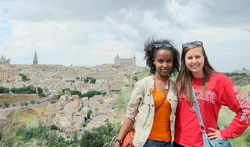 Friday afternoon around 3 pm we left Segovia to embark upon our final excursion to Toledo and Madrid. After a two-hour drive we arrived to the beautiful city of Toledo. Toledo is enclosed by a river called El Río Tajo which is one of the most important rivers in Spain. After checking in the hotel we walked through the city with our professors and learned some of the history of Toledo including the towers constructed by Arabs. After an hour we were had a few hours of free time and we went our separate ways and did a variety of things including visiting a museum, an antique store, and shopping at store filled with American products called a Taste of America. Later that night we dined in the hotel and some of us headed out to experience Toledo at night.
The next morning we got up early to visit one more historic site in Toledo, the extraordinary cathedral. The cathedral in Toledo is one of three Gothic-styled cathedrals and the church was built in the same place a mosque previously stood and inside there the Arabic designs can be seen. The most impressive sight in the cathedral was the retablo which is the decorative piece located behind the altar. The retablo contains series of paintings depicting the life of Christ and in contrast to the cathedral in Salamanca, the retablo are actual wooden sculptures that were painted. After leaving the cathedral we had an hour of free time we headed at restaurant where some of us tried a traditional Spanish meal called calcamuses. After lunch we spent the afternoon in Madrid where we visited El Museo Nacional Centro de Arte Reina Sofía which houses several contemporary art pieces from artists including Pablo Picasso, Ignacio Zuloaga and Juan Gris. After leaving the museum we all decided to eat churros con chocolate for the last time together and afterwards headed back to Segovia for our last few days.
A las tres de la tarde salimos para Toledo y Madrid para nuestra ultima excursión. Después de dos horas llegamos a la ciudad bella de Toledo. La ciudad se encierra por El Rio Tajo, uno de los ríos mas importantes en España. Caminamos por la ciudad para aprender las historia de la ciudad. Despues nos separamos para explorar la ciudad e ir de compras. A la noche cenamos en el hotel y después unos de nosotros fueron para disfrutar la vida de la noche.
La próxima mañana nos despertamos para visitar otro sitio de Toledo, La Catedral. La catedral de Toledo es uno de las tres catedrales del estilo gótico. Antes de la construcción de la catedral había un mezquita que los cristiano destruyeron para construir la catedral. La vista mas preciosa en la catedral fue el retablo con las esculturas de madera de la vida de Jesús Cristo. Luego fuimos al restaurante para comer. Tomamos comidas diferentes incluyendo paella, pisto, macarrones y una comida tradicional que se llamaba calcamuses. Después de comer, fuimos a Madrid para visitar El Museo Nacional Centro de Arte Reina Sofía que contiene obras de Picasso, Zuloaga y Juan Gris. Antes de salir comimos churros con chocolate juntos por la ultima vez y salimos para Segovia.
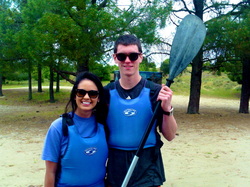 Emily McEvoy and Ben Gillespie Thursday, June 6th our group took a trip to Hoces del Duratón Natural Park to go Kayaking. Hoces del Duratón Natural Park is located about an hour bus ride away from Segovia. The name of the park refers to the Duratón River and "Las Hoces" refers to the series of 100m high gorges that were formed by the Duratón and literally translates to “The Scythes” because of the shape of the river. When we first arrived we got suited up in our life jackets then practiced using the oars. Our guide then took us down to the river and we got into our kayaks. The park was beautiful and exploring it in our kayaks was really fun. We got to see huge birds such as the Griffon Vulture and the Egyptian Vulture. Our guide told us that the Griffon Vulture is about 3-4 feet long with a 7–9 foot wingspan. They were amazing creatures to watch fly over the gorges.
After Kayaking through the river for about an hour and a half we left to have lunch in Sepúlveda. On the way to Sepúlveda we stopped at a lookout of the park so we could get some pictures. The view was breathtaking. After eating lunch in Sepúlveda we explored the town for about an hour, enjoyed the views, and bought some ceramics that were made in the town. It was a fun-filled, and very tiring day.
Jueves, 06 de junio nuestro grupo hizo un viaje al Parque Natural Hoces del Duratón en kayak. El Parque Natural Hoces del Duratón se encuentra a una hora de viaje en autobús de Segovia. El nombre del parque se refiere al río Duratón y "Las Hoces" se refiere a la serie de quebradas altas 100m que se formaron por el Duratón y literalmente se traduce como "The Scythes" debido a la forma del río.. Nuestro guía nos llevó después hacia el río y nos metimos en nuestros kayaks. El parque era hermoso y su exploración en nuestros kayaks fue muy divertido. Llegamos a ver grandes aves como el Buitre de Griffon y el Buitre Egipcio. Nuestro guía nos dijo que el Buitre de Griffon es cerca de 3-4 pies de largo con una envergadura de 7-9 pies. Eran criaturas increíbles para ver volar a través de los desfiladeros.
Después de Kayak por el río durante aproximadamente una hora y media nos fuimos a almorzar en Sepúlveda. En el camino a Sepúlveda nos detuvimos en un mirador del parque, así que pudimos tomar algunas fotos. La vista era impresionante. Después de comer el almuerzo en Sepúlveda exploramos la ciudad durante aproximadamente una hora, disfrutamos de las vistas, y compramos algunas cerámicas que se hicieron en la ciudad. Fue un día lleno de diversión y estábamos muy cansados después.
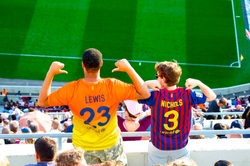 Today's Bloggers are Jamel Lewis and Sam Nichols
This past weekend we had the pleasure of spending four nights in the incredible Mediterranean city of Barcelona. Encompassing just over 310 sq mi, and being home to 1.62 million inhabitants, Barcelona is the second largest city in Spain and the sixth most populous urban area in the European Union. The city is a major tourist destination for people all over the world with unique attractions such as the architectural works of Antoni Gaudí, open-air markets, designer fashion outlets, a world-class football team, beautiful beaches, and a very energetic nightlife.
Being that it was a truly free weekend we were all able to do as much or as little as we wanted but most of the group opted to do a bit of everything. Everyone managed to see at least one of Gaudí’s architectural masterpieces (Casa Mila, Sagrada Familia, Park Güell, Casa Batlló, etc.), visit at least one of the many beaches around the city, see the la Boqueria market at La Rambla, buy at least one souvenir, witness some of the nightlife, and go to a Barcelona soccer game. Coming from Segovia it was a thrill to experience the modern and vibrant metropolis that is Barcelona and hopefully we will someday have the chance to go back and see the things we may have missed the first time around.
***************************
El fin de semana pasado, nosotros tuvimos el placer de pasar cuatro noches en la bella ciudad mediterránea de Barcelona. Barcelona tiene 1,62 millones de habitantes y también es la segunda ciudad más grande en España y la sexta área urbana más poblada de la Unión Europea. Esta ciudad es un mayor destino turístico para personas de todo el mundo. Hay muchas atracciones únicas como las obras de Antoni Gaudí, mercado al aire libre, tiendas de moda de diseño, un equipo de fútbol de primer nivel, bellas playas, y una vida nocturna muy energética.
Siendo que era un fin de semana libre nosotros podíamos haber hecho tanto o tan poco como queríamos, pero la mayoría del grupo optamos por hacer un poco de todo. Todos nosotros pudimos ver al menos una de las obras maestras arquitectónicas de Gaudí (Casa Mila, Sagrada Familia, Park Güell, Casa Batlló, etc.), visitar algunas de las playas alrededor de Barcelona, ver el mercado de la Boquería en la Rambla, comprar al menos un recuerdo, testigo de algunos de la vida nocturna, e ir a un partido de fútbol de Barcelona. Viniendo de Segovia fue emocionante de experimentar la metrópolis moderna y vibrante que es el Barcelona. Espero que algún día vayamos a tener la oportunidad de volver y ver las cosas que pudimos haber perdido la primera vez.
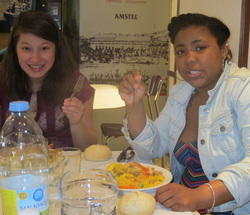 Today's blog was written by Victoria Pray and Kiona Deans. *Kiona will probably kill McConnell when she sees this photo so it will be changed later today after we take a new one!
After arriving in Madrid, we headed over to the Royal Palace of Madrid. King Charles III was the first king to live in the palace and he started living there in 1764. The architecture in the palace is Italian and the styles of each room changes with each room but the main styles are baroque and neo-classical. This palace is not just a museum, but royalty (Juan Carlos I and Sofia) come here a couple times a month for either celebration or business. The last king to actually live there year-round was Alfonso XIII and that was in 1931. Some kings collected certain items such as clocks, tapestries, and chandeliers, which shows because there is at least one in almost every room. Some of the rooms have new items such as carpets and drapes but other rooms such as the throne room have not been changed since 1764. The king and queen no longer sit on the thrones because they are now part democratic monarchy and they don’t have absolute power. One room we saw – the dressing room – was completely made of porcelain, which can be taken apart at any moment because the porcelain is screwed into wood. Carlos III apparently had three different porcelain dressing rooms that he kept. In the past, the main dining room table had so many bronze pieces, fruit, and flowers as centerpieces (to show power) that the guests were unable to see each other. Now, however, there is a more modest centerpiece.
Next, we visited the Museo del Prado. Luis mainly showed us paintings from Diego Velázquez and Francisco de Goya. Velázquez was the official painter of the royal family and when they traveled to Italy, he came with them. Because of this, he inspired Italian painters in their style. Goya also painted royalty at first, but after the Napoleonic War, his attitude towards the Spanish government changed, which led to his “pinturas negras” (translated as black paintings). These paintings are much more embittered and bleak with disturbing images such as his famous “Saturn.” After the museum, we went to lunch at the Hotel Mora and did some sightseeing before leaving for Segovia.
En Madrid, el grupo visitó el Palacio Real de Madrid. Carlos III fue el primer rey para vivir en el palacio en 1764. La arquitectura en el palacio es de Italia y los estilos de los cuartos incluyen barroco y neo-clásico. Alfonso XIII fue el ultimo rey para vivir permanente en el palacio, pero Juan Carlos I y Sofía visitan el palacio durante el mes. Unos reyes han coleccionado unas cosas como relojes, tapices, y arañas y cada cuarto tiene al menos uno de cada cosa. El cuarto de trono es el único cuarto que no ha cambiado desde 1764. El rey y la reina no se sientan en los tronos porque ahora, son parte de una monarquía democrática. El vestuario está hecho de porcelana y se puede estar desatornillado de la madera del pared. En el pasado, la central de la mesa tenía muchas piezas de bronce, frutas, y flores que los huéspedes no podían ver el uno al otro pero ahora el mesa tiene una central modesta.
Después del palacio, visitamos el Museo de Prado donde vimos las pinturas de Diego Velázquez, Francisco de Goya, y otros pintores. Aprendimos que Velázquez fue el pintor de la familia real y visitó Italia con la familia. En Italia, influyó los estilos de los pintores italianos. Goya pintó una familia real también, pero después de la Guerra Napoleónica, sus pinturas cambiaron porque su perspectiva del gobierno y humanidad se hizo desolado y oscuro. Después del museo, comimos al Hotel Mora y exploramos la ciudad de Madrid. Fue un día bueno y lleno de paisajes hermosos.
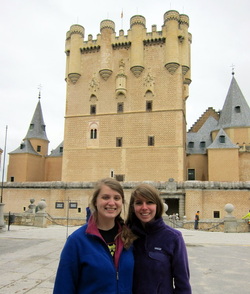 On Thursday, May 30th we took a trip to one of Segovia’s most celebrated landmarks, The Alcazar. The first record of the Alcazar of Segovia dates back to the 12th century. The design of the Alcazar features inspiration from many different cultures, including Arabic, Christian, Romanesque and Celtic. An example of this is the zigzag entrance to the castle. All castles of the Arabic tradition have zigzag entrances as a defense mechanism, preventing the easy entrance of the enemy’s armored horses.
One of the most impressive features of the Alcazar is the castle’s intricate ceiling of Arabic design. Perhaps the most impressive was the monarch’s room which featured sculptures of the past monarchs of Asturias, Castille and Leon. These historical rooms also boasted a breath taking view of the beautiful Segovian landscape. As you make your exit, you can’t help but notice the 140 foot drop into the castle’s medieval moat. Though now empty, it is still an intimidating sight and some of the group were afraid to look over the bridge. All in all, it was an exciting way to start off our Barcelona weekend!
Fun fact: The Alcazar of Segovia was the prime inspiration for the Cinderella castle in Disney World, Florida.
Jueves, el 30 de mayo, visitamos una de las más celebradas e históricas marcas de Segovia, El Alcázar. El primer registro del Alcázar de Segovia feu al iniicon del siglo 12. El diseño del Alcazar fue insiprado por muchas culturas diferentes, incluido el árabe, cristiana, románica y celta. Un ejemplo de esto es la entrada en zigzag al castillo. Todos los castillos de la tradición árabe tienen “zigzag” entradas como mecanismo de defense.
Una de las características más impresionantes del Alcázar es el techo complejo de diseño árabe. Lo más impresionante fue la sala de Reyes que tiene esculturas de los últimos monarcas de Asturias, Castilla y León. Estas salas históricas también tienen vistas bonitas del paisaje de Segovia. Cuando uno slae del castilo, no se puede dejar de notar la caída de 140 pies en el foso medieval del castillo. Aunque ahora vacío, sigue siendo un espectáculo intimidatorio y algunos del grupo se atrevieron a mirar por encima. En general, fue un buen modo de empezar nuestro fin de semana en Barcelona!
Dato curioso: El Alcázar de Segovia fue la inspiración principal para el castillo de Cenicienta en Disney World, Florida.
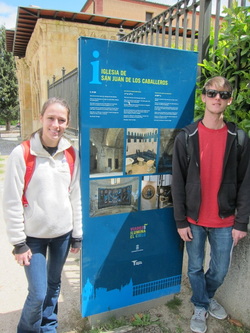 By Jesse Poovey and Sarah Walters
Wednesday, the 29th, we went to the Museo Zuloaga after class. Built in the 6th century, San Juan de los Caballeros is the oldest church in Segovia, which now is home to a museum of pottery and ceramics. In 1905, Daniel Zuloaga bought the abandoned church to convert it into his workshop. Here he made and sold pottery and other ceramics until his death in 1921. Zuloaga had four children, who all were a part of his business. His workshop was also used by another important ceramicist, Zuloaga’s nephew, Ignacio. Later, in 1955, the state bought the building to convert it into the museum.
It was very interesting to see such an ancient church in such good condition without much remodeling. The artwork and ceramic pottery was well preserved and the walk-through was well displayed. It was also interesting to see the sketches Zuloaga made during his time in the building. Overall, this was a very interesting and insightful look into a piece of the history of ceramic art in Segovia.
Miércoles, el 29 de mayo, fuimos al Museo Zuloaga después de clase. Construido en el siglo seis, San Juan de los Cabelleros es la iglesia más vieja en Segovia, la cual es la casa de un museo de alfarería y cerámica. En 1905, Daniel Zuloaga compró la iglesia abandonada para cambiarla a su taller. Aquí él hizo y vendió alfarería y cerámica hasta que se murió en 1921. Zuloaga tuvo cuatro hijos y fueron parte de su impresa también. Su taller fue usado por otro ceramista importante, su sobrino, Ignacio. Luego, en 1955, el estado compró el edificio para convertirlo en un museo.
Fue muy interesante ver una iglesia antigua en buenas condiciones sin mucha remodelación. Las obras de arte y cerámicas se han conservado bien y la gira mostró bien. Fue interesante ver los bocetos hizo por Zuloaga durante su duración en el edificio. De todas maneras, fue una gira muy interesante y perspicaz a la historia de arte cerámica en Segovia.
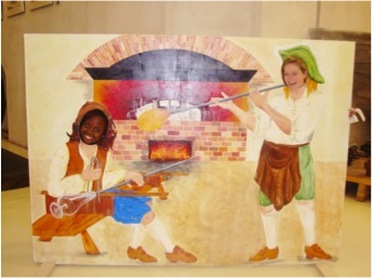
Today we went to La Granja, which is located about 25 minutes away from Segovia. The weather was cold and rainy. Fortunately our first destination, the Palacio Real, was inside. The Palacio Real used to be the king and queen of Spain's summer home from 1741 to 1971. The palace is modeled after the Palace of Versailles in France and it has some artifacts that were made in France, however, almost everything within the palace was made in Spain. Within the palace there are many Flemish tapestries from the 16th century. There are stunning paintings on every wall in the Palace of former nobility and on the ceiling there are famous frescos from the 18th century. Sadly in 1918, there was a fire in the palace that burned for 2 days. While the caretakers were able to save most of the paintings on the walls, there were a few rooms where the frescos had burned off.
After the Palacio Real we went to the glass factory. The glass factory was built near the palace because so much glass was needed for the Palacio Real. They acquired their glass making technique from the French and gathered their materials from northern Spain. Inside the factory, there are many types of glass in the form of art and cups. We were able to visit a workshop where they currently make glass - they use an oven to heat the glass and multiple workers to form each piece. In another part of the glass factory's museum we saw different parts of the old factory machinery. After seeing all of these amazing things, the weather was finally warm and sunny, so we were comfortable as we waited for our bus back to Segovia.
In general it was an incredibly informative and fun day for everyone!
Hoy, la clase visitó el Palacio Real y la Fábrica de Cristal en La Granja, un pueblo cerca de Segovia. Muy temprano, tomamos el autobús a La Granja y hacía mal tiempo. Estábamos muy aliviados a llegar al Palacio Real después de caminar en La Granja. En el Palacio, vimos muchas cosas muy antiguas y exquisitas. Estaba las tapices, muchas pinturas, las estatuas, los muebles, y los frescos. En unas partes del Palacio, no hay frescos porque hubo un incendio en al año 1918 que destruyó unas salas. Después del tour, caminamos en los jardines del Palacio. Vimos muchas fuentes – hay veintiséis fuentes en los jardines. También visitamos el embalse que suple agua a las fuentes.
En la tarde el tiempo hacía buen tiempo. Caminamos un poco en el pueblo y luego visitamos la Fábrica de Cristal. La Fábrica tiene una parte como un museo. Allí vimos vidrio en muchas formas – el arte, los espejos, y muchos vasos. El parte más interesante era cuando observamos personas haciendo de mano los vasos de cristal. Su talento es increíble.
En el fin del día, a pesar del mal tiempo, are un buena excursión y nos disfrutamos mucho.
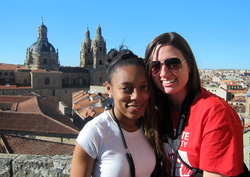 On Friday the 24th we left to spend the night in Salamanca, a larger city that is about 2 hours west of Segovia.
After a bus ride of siestas, we checked into a luxurious 5 star hotel called “Hotel Alameda Palace.” We quickly dropped our bags in our room and then left to explore the city. We immediately fell in love with Salamanca! We headed off to see the Plaza Mayor, which is one of the most well-known Plazas in Spain. The Plaza consists of four walls with a large open area in the center where both locals and tourists hangout. We also visited the Cathedral of Salamanca. It consists of an older Gothic section which was built in the 12th century and a newer Baroque section which was built in the 16th century. From the top of the cathedral we were able to see the skyline of Salamanca. We also spent time looking at the facades and architecture of the Universidad de Salamanca.
After some free time the group met in the hotel for dinner. The meal included spinach-stuffed canneloni and salmon with a slice of lemon cake for dessert. Later that night the group went out to view the beautifully lit Plaza Mayor and to experience a night in Salamanca.
On Saturday morning we went back to the cathedral for a more in depth look at the structure of the interior. After eating lunch in Salamanca we left for Avila, which was about 45 minutes away. Avila is most known for its well-conserved medieval wall surrounding the city. We stayed in the city just long enough to take pictures and explore. Some of the group ventured to the top of the wall for some amazing sites while others chose to rest in the Plaza Mayor.
Upon returning to Segovia at 7:30 in the evening we were all grateful for the weekend excursion, but we were excited to be back in Segovia to rest!
Y ahora...¡en español!
Viernes, el 24, salimos para quedarnos una noche en Salamanca, una ciudad grande que está dos horas al oeste de Segovia.
Después de siestas en el autobús, firmamos el registro en un hótel lujoso de 5 estrellas que se llama “Hotel Alameda Palace.” Luego, fuimos a la Catedral de Salamanca que consiste de una parte antigua y otra nueva. También, vimos las fachadas de la Universidad de Salamanca y la Plaza Mayor que es muy famosa por tener mucha gente. Cenamos en el hotel y fuimos por la noche para ver la ciudad.
El sábado visitamos la catedral otra vez para ver el interior. Almorzamos en Salamanca y después salimos para otra ciudad que se llama Ávila. La ciudad es bien-conocida para la muralla medieval bien-conservada. Allí pasamos tiempo en la plaza mayor y tomamos unas fotos por la muralla.
Regresamos a Segovia a las 7:30 por la noche. Disfrutamos mucho nuestra excursión, pero a la misma vez nos pusimos alegres de devolver a nuestras casas en Segovia.
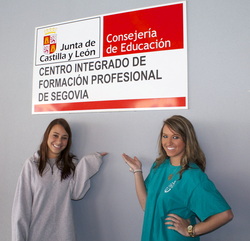 Thursday, May 23rd, our class took a trip to New Segovia to take a cooking class at the vocational school there. The school offers majors such as cooking, hospitality & tourism, English, and cosmetology. Bernardo, the chef, taught our class the basics of making Paella. Paella is a dish that is a Spanish favorite that contains rice, seafood, mushrooms, chicken, peppers and a type of stock. Bernardo instructed us on the process of making Paella and gave us all a chance to cook. After sautéing the chicken and peppers in two large pans, we added the shrimp with its complete shell. The shell of the shrimp is kept on in order to add to the flavor of the dish. Next, we added muscles, garlic, tomato sauce, wild mushrooms, and red & green peppers. After cooking all of these ingredients together, we added the rice, followed by the fish stock that is used to cook the rice. In order to solidify the dish, Bernardo added a special step in which you put the dish in the oven until it is done cooking. After we all tried and enjoyed the Paella, we met some of the students who attended the school. They practiced their English with us, while we practiced our Spanish with them and also made some new friends. We all had a great day and learned how to make an exceptional dish that we can now cook for our families in America.
Si hablas español...
Jueves, 23 de mayo, la clase hizo un viaje a Nueva Segovia para tomar una clase de cocina en la escuela vocacional allí. La escuela ofrece especialidades como cocina, hostelería y turismo, inglés, y cosmetología. Bernardo, el chef, enseñó a nuestra clase los fundamentos de hacer paella. La paella es un plato que es uno de los favoritos españoles que contiene arroz, mariscos, champiñones, pollo, pimientos y un tipo de caldo. Bernardo nos instruyó en el proceso de hacer paella y nos dio a todos la oportunidad de cocinar. Después de saltear el pollo y los pimientos en dos grandes paelleras, añadimos las gambas con su concha completa. La concha de los camarones se mantiene para añadir el sabor al plato. A continuación, añadimos los mejillones, ajo, salsa de tomate, setas y pimientos rojos y verdes. Después de la cocción todos estos ingredientes juntos, añadimos el arroz, seguido de caldo de pescado que se utiliza para cocinar el arroz. Para solidificar el plato, Bernardo añade una paso especial en el que se pone el plato en el horno hasta que se hace la cocción. Después de que todos probamos y disfrutamos de la Paella, nos encontramos con algunos de los estudiantes que asistieron a la escuela. Ellos practicaron su inglés con nosotros, mientras practicamos nuestro español con ellos y también hicimos algunos nuevos amigos. Todos tuvimos un gran día y aprendimos a hacer un plato excepcional que ahora podemos cocinar para nuestras familias en los Estados Unidos.
 The first stop of our excursion was a monastery in Santa Maria La Real de Nieva. There were several large columns that surrounded the monastery, each topped with a religious image or symbol. We learned that Lilies symbolize the purity of the Virgin Mary and hunting lions symbolize the killing original sin. Although the monastery was built in a Romantic style, there was a gothic influence in the arches of the columns. We learned a lot about the religious art and symbolism in the monastery.
After the monastery, we went to a winery that is famous for their white wines. We studied the machinery and learned about the engineering behind the winemaking process. We learned about one machine in particular that would slightly pop the grapes and then apply pressure to release the liquid. Nitrogen is then pumped into the mixture to prevent oxidation of the wine. In large tanks, the sediment is separated from the liquid by the force of gravity. Next, the temperature is lowered to prevent the natural yeasts from fermenting for too long. Clay is then added to attract the proteins in the wine to reduce the cloudiness and clarify the wine. We also learned that the salt byproducts from the process are sold to makeup companies for exfoliants.
Our next stop was visiting a restored castle in Coca. The first room in the castle was an adoration room with pews and a tabernacle. We then climbed up the winding stairwells to explore the other rooms of the castle. One of the rooms we visited reminded us of the Wolves Ears at NC State. In the room, we stood far away from a friend and talked into the wall and we could hear each other perfectly. We continued climbing to the roof of the castle where we could see for miles in every direction. Even in the rain, the view was spectacular.
After lots of exploring, we were all ready for a delicious lunch. We ate lunch in a small town called Turegano. We ate lamb and gazpacho, traditional meals in that region. We drank red wine with gaseosa, which slightly carbonated our beverages. This is very Spanish and makes it able for you to drink a glass of wine without getting intoxicated. For dessert, we enjoyed home made Flan.
After lunch we went to Pedraza, a city surrounded entirely by walls with only one door. While we walked up, each car entering and leaving the city had to take turns driving through the door. We walked around the city and took lots of photographs. It was really interesting to see so many old castles because there is nothing like that at home in the United States.
After a long day at the Monastery, the Winery, and La Ruta de los Castillos, everyone was ready for a well-earned siesta!
Si hablas español, sigue leyendo…
Ayer, fuimos a un monasterio para estudiar todos los imágenes y símbolos religiosos en los capiteles. Nos gustó aprender sobre el estilo de la arquitectura y como es románico pero los arcos son góticos. Después, fuimos a un viñedo y una bodega para aprender sobre los vinos. Aprendimos cómo funcionan las máquinas y cómo se producen los productos. Probamos los varios tipos de vino y nos gustaron mucho. Luego pasamos mucho tiempo en La Ruta de los Castillos. Aunque llovía mucho, nos divertimos porque no hay nada como los castillos antiguos en los Estados Unidos. Fue muy interesante y aprendimos mucho sobre los castillos. Después de mucho ejercicio caminando en los castillos, teníamos mucho hambre. Almorzamos en un restaurante y comimos cordero y gazpacho, comida típica de esa región. Luego, visitamos una cuidad con murallas en su alrededor y solo una puerta. La excursión fue muy impresionante y una nueva experiencia muy divertida para todos.
|









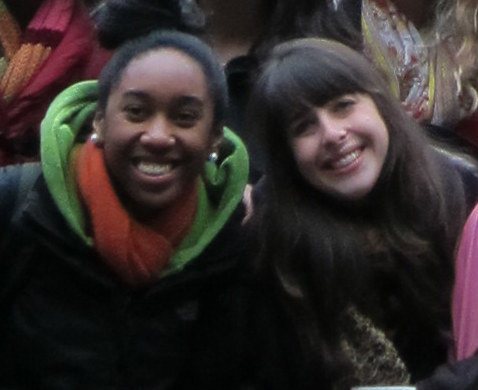

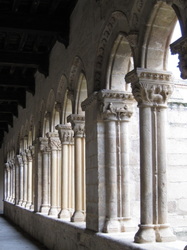
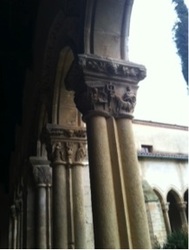
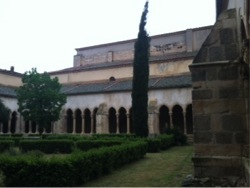
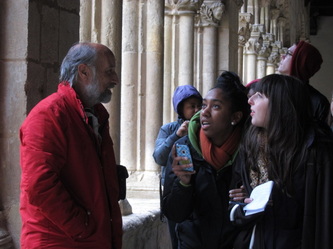
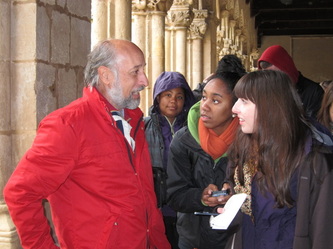
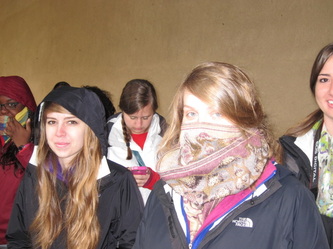
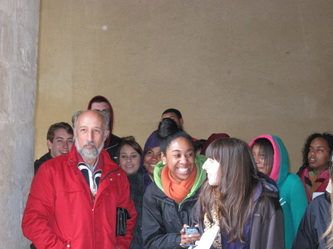
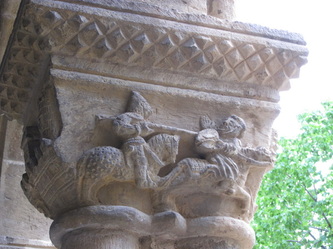
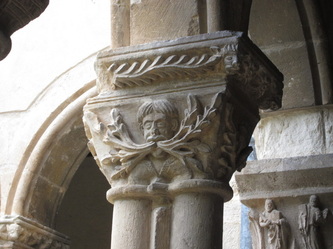
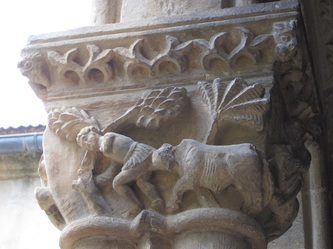
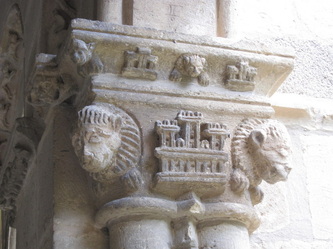
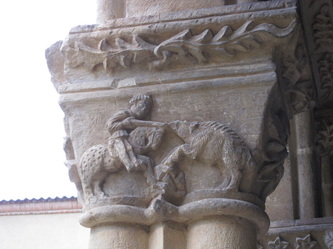
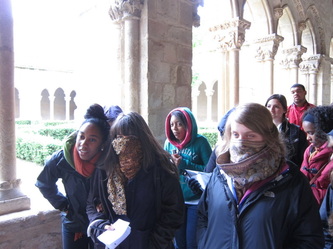
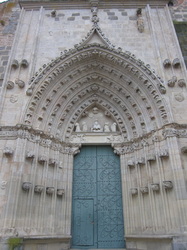
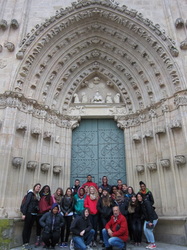
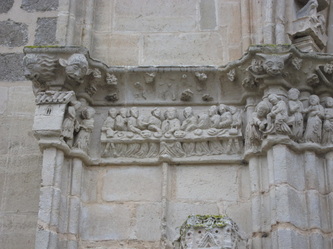
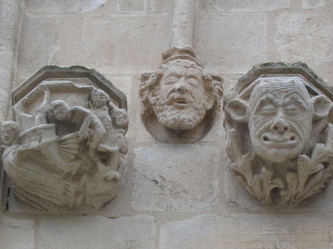
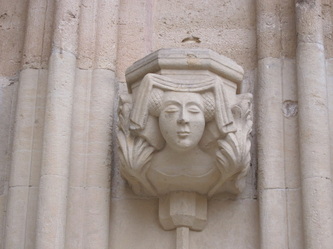
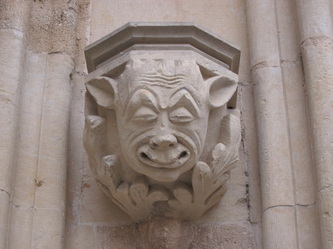
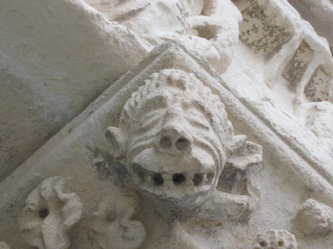
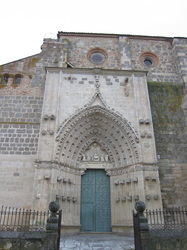
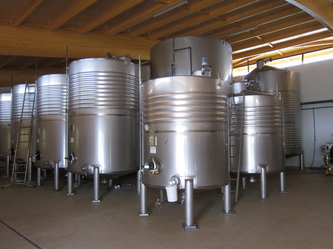
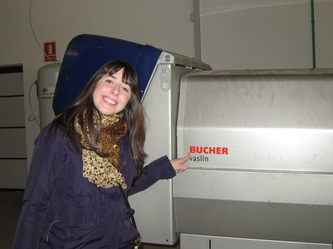
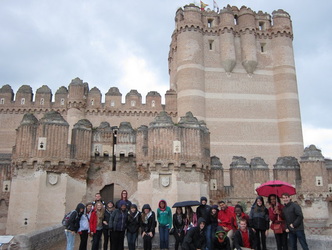
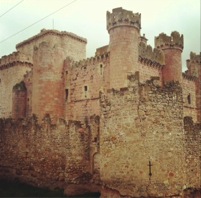
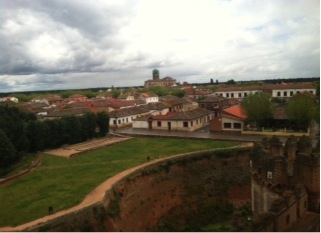
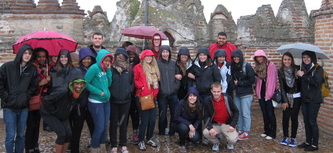
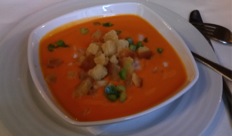
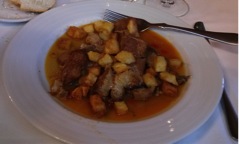
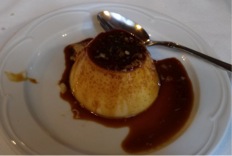
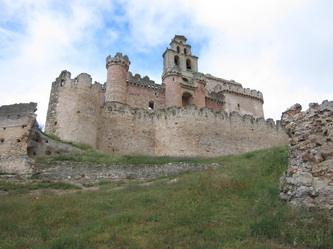
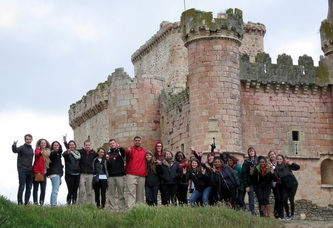
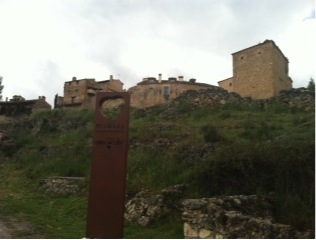
 RSS Feed
RSS Feed